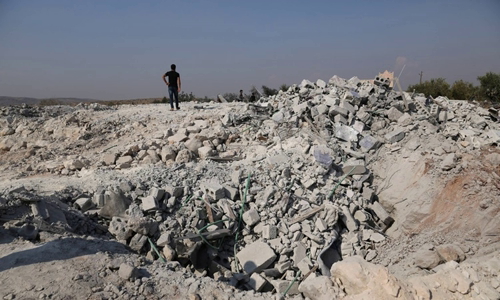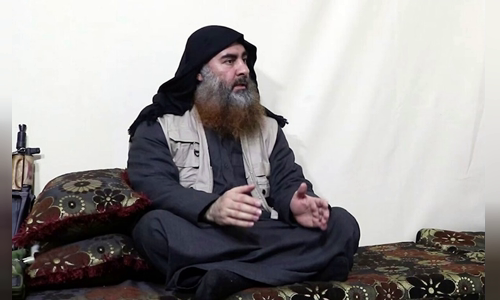Baghdadi always believed in his security measures, but eventually died of being betrayed by an insider in the organization.
US commanders found the last hideout of the Islamic State (IS) leader, Abu Bakr al-Baghdadi, thanks to an extremely accurate insider source, who was once an IS member. responsible for coordinating every movement of the "tycoon" around Syria and even taking part in supervising the construction of a safe shelter for Baghdadi, according to US and Middle East sources familiar with the matter.

Rubble in the hideout of ISIS leader Baghdadi after US troops raided on October 26 Photo: NYTimes
Details insider sources, who the US intelligence called a "mole", provided the location of Baghdadi as well as a diagram of his tunnel under the building believed to be one of the factors. key to the raid campaign that ended Baghdadi's life on October 26.
The "mole" was involved in a raid on Baghdadi's hideout in Idlib province, northwestern Syria, and two days later he was removed from the area with his family. The man, whose nationality is unknown, is expected to receive part or all of the $ 25 million that the US offered to reward or kill Baghdadi.
An official said the source was a Sunni Arab who betrayed IS because many of his relatives were killed by the terrorist group.
Initially, the Kurdish Democratic Forces (SDF) of the Kurds approached and persuaded the source to become insiders, then handed over the "moles" to US intelligence. US agents have been investigating this person for weeks to make sure he provides true information.
US intelligence has been trying to find ways to collect information about Baghdadi's whereabouts since the middle of this year, but the data provided by the "mole" in September is considered a breakthrough creating opportunities for action. American side.
"We have assessed that this person can hold the key to helping solve the deadlock," said a US official with knowledge of the matter. "Things have only started to become clear in the past few weeks." Descriptions of insider sources and his contributions were provided by two former US officials and a Middle East official, who did not know the Baghdadi raid.
US and Middle East officials say the raid against Baghdadi is in fact the result of years of coordinated efforts with foreign partners and allies. Since at least 2015, US commandos, along with Iraqi and Kurdish units, have been involved in special operations to search for Baghdadi and other high-ranking IS leaders. They have achieved some success, such as killing IS propaganda leader Abu Muhammad al-Adnani in 2016. However, Baghdadi is a much more elusive target because he is constantly moving and not using it. mobile phones or other tracking devices.
According to a Middle East official who knows the details of the search, the focus of the hunt has shifted to the region of Idlib this summer. The campaign was joined by top US and French agents and state-of-the-art surveillance equipment.
Idlib, a province occupied by militant groups and located far from ISIS bases, was initially overlooked by US intelligence. "No one can enter the area," especially extremist Islamists, US officials said. "The Russians control airspace."
But with the help of sources, US officials have narrowed their focus to the town of Barisha in northwestern Idlib, where Baghdadi is hiding in a strict security complex with countless tunnels. Planning for the campaign was launched on October 23 with the expectation that the leader of the IS could be captured.

The Supreme Leader of the Islamic State (IS), calling himself Abu Bakr al-Baghdadi, appeared in a propaganda video in April. Photo: AFP
An official said the "mole" was a man with a reliable internal advisory and logistical support within IS, having helped Baghdadi move back and forth between safe havens in Idlib before moved to the building where he was annihilated.
An insider source, described as an active and enthusiastic participant in the mission, revealed very important personal information about the IS recluse leader, including his always wearing a bomb belt whenever Move to commit suicide if cornered. The "mole" is so leader of the IS leader that he sometimes escorts Baghdadi family members to a medical center.
After gathering all the important information, members of the Delta Force and the 75th US Army Commandos Regiment and the dogs team on October 26 conducted the raid.
Attack forces surrounded the site and called for Baghdadi to surrender. More than 10 children and several adults in turn fled from the shelter but Baghdadi still entrenched inside. He ran down the tunnel with three children, but he was finally cornered.
Commandos stormed Baghdadi's hideout after a gun battle and then drove him down a tunnel below the building. Baghdadi detonated a suicide bomb belt after being chased by a professional dog. He and his three children were buried under the rubble of the tunnel. Baghdadi's wives were also killed in the operation.
According to US officials, the informant was always given special care to avoid a repeat of the tragedy of the US Central Intelligence Agency (CIA) in Khost, Afghanistan, in 2009, when a Jordanian insider was given There was information about al-Qaeda leader activating suicide bombs that killed seven US intelligence agents and an Afghan driver.
A US official said the source changed sides because he "lost faith" in IS. Although with the help of the source, the plan to capture or destroy Baghdadi was canceled and delayed several times because the field situation changed quickly.
"I can't remember how many times we thought we were going to catch him," US officials said. "For the past few months, we felt like we were about to reach our destination, but only last month did we realize that 'this time is real'."
Baghdadi's head seemed to have remained intact after he detonated the suicide bomb belt, so the operations executives believed he had actually been destroyed before the DNA test results were available. A commander at the time spoke on the radio with an excited voice: "Look, it's Baghdadi. That's the trick."



 TahesherPinkishSmilezAnderson
TahesherPinkishSmilezAnderson







